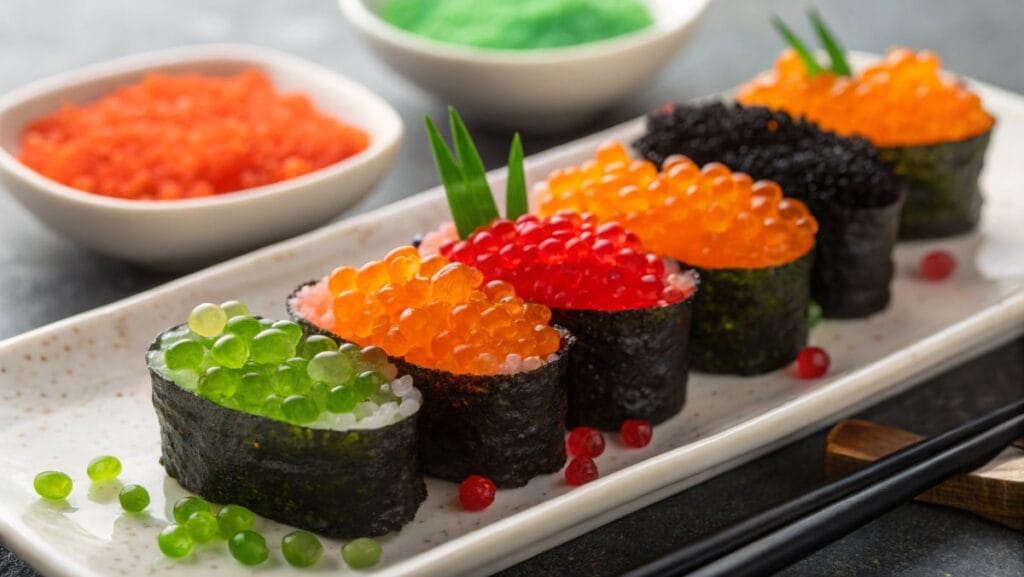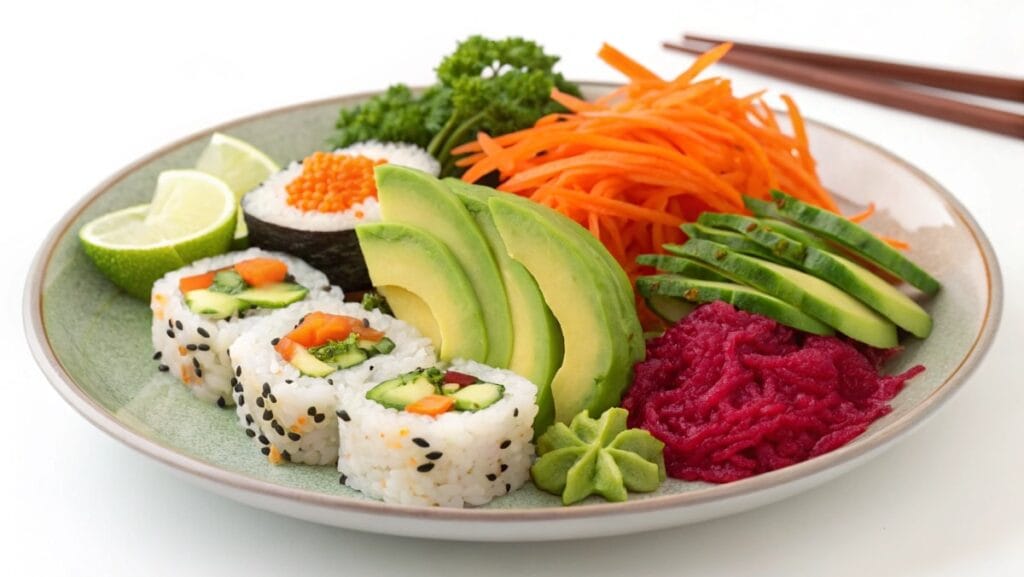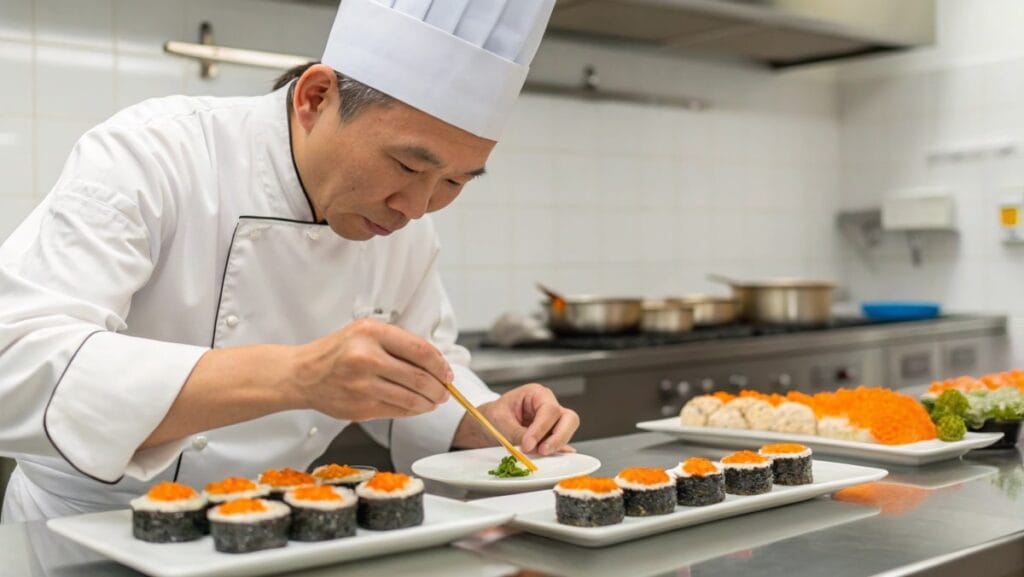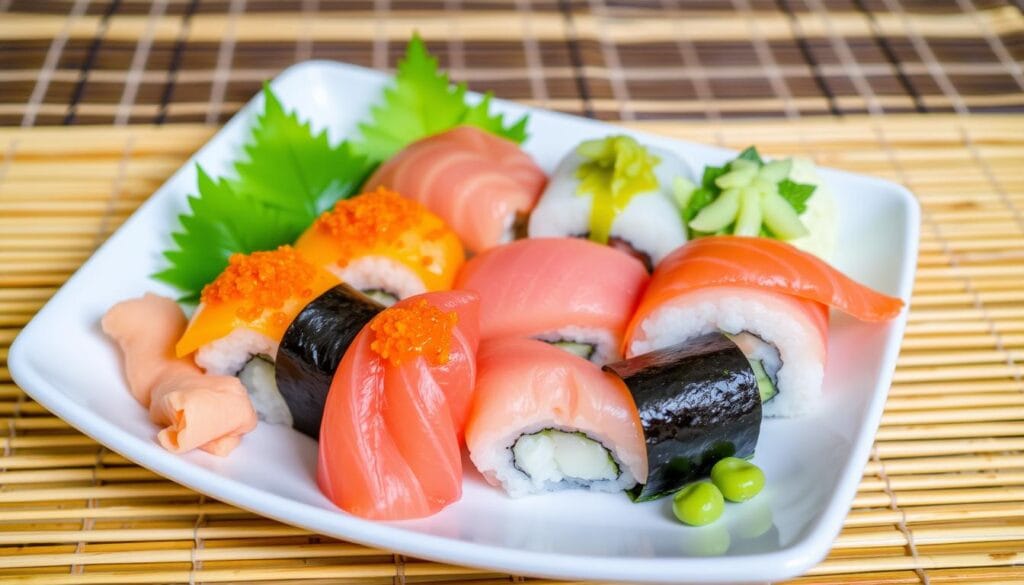Imagine being at a sushi bar, savoring the unique texture of tobiko eggs. These tiny, vibrant fish roe are why tobiko is essential in sushi, adding a delightful crunch and flavor to every bite. You take a bite of a sushi roll and find a delightful crunch. This is thanks to tobiko eggs, also known as flying fish roe.
Their bright colors and unique texture make sushi even better. They open up a world of flavors that are both exciting and unforgettable. In this article, we’ll explore where tobiko caviar comes from and its health benefits.
Table of Contents
What Are Tobiko Eggs?

What are tobiko eggs? These vibrant flying fish roe are a staple in sushi dishes, prized for their unique texture and ability to elevate any culinary creation. These tiny, vibrant eggs are primarily harvested in Japan, where they have long been cherished in culinary traditions. Ranging from 0.5 to 0.8 mm in diameter, tobiko eggs are recognized for their stunning colors, predominantly orange, but they can also be found in green, black, and red due to different flavor infusions. The allure of tobiko lies not only in its visual appeal but also in its nutritious profile and beneficial properties.
Definition and Origin
Originating from the roe of flying fish, tobiko has become increasingly popular outside Japan. The harvesting process involves careful collection and preparation, ensuring that the delicate eggs maintain their luscious qualities. While traditionally used in Japanese cuisine, their delightful taste allows them to complement various international dishes.
Nutritional Benefits
Tobiko eggs nutrition highlights their rich content of protein, omega-3 fatty acids, and essential vitamins, making tobiko caviar a healthy addition to any meal. These eggs provide high-quality protein and are packed with omega-3 fatty acids, essential for heart and brain health. Regular consumption offers several tobiko benefits, such as supporting cardiovascular health and enhancing mental function. Additionally, tobiko eggs contain important vitamins, including B12, which contributes to overall well-being and energy levels.
| Nutrient | Amount per 100g | Benefit |
|---|---|---|
| Protein | 30g | Supports muscle growth and repair |
| Omega-3 Fatty Acids | 1g | Promotes heart health and cognitive function |
| Vitamin B12 | 13µg | Essential for energy production and nerve function |
| Calories | 170 | Provides energy for daily activities |

The Distinctive Flavor Profile of Tobiko
Tobiko roe has a unique flavor that makes dishes special, especially in sushi. It combines sweet and salty tastes in a perfect way. This mix makes tobiko a standout ingredient in many recipes.
Sweet vs. Salty Notes
When you try tobiko, you first notice a hint of sweetness. This sweetness contrasts with the roe’s natural saltiness. This contrast leaves a refreshing taste that makes tobiko great in many dishes. In sushi, it highlights both sweet and salty flavors with every bite.
Umami Characteristics
Tobiko is also known for its deep umami flavor. Umami is the fifth taste and adds a lot to a meal. It makes tobiko a top pick for sushi, blending well with other ingredients. This results in a more enjoyable dish.
How Tobiko Eggs Are Harvested
The process of harvesting tobiko is very careful. It’s done to keep the delicate nature of tobiko roe safe. Fishermen look for flying fish during their best time to spawn. This ensures the quality is top-notch.
After catching the fish, getting the roe is a detailed task. It needs a lot of care and a focus on keeping it fresh.
The Harvesting Process
To harvest tobiko right, follow these steps:
- Identifying the spawning season of flying fish.
- Using nets to gently catch the fish without damaging them.
- Carefully extracting the roe, ensuring minimal exposure to air to maintain quality.
- Processing the tobiko roe immediately to preserve its flavor and texture.
Sustainability Practices
It’s key to focus on sustainable fishing for flying fish. Many suppliers follow rules to protect the sea. They use methods like:
- Utilizing selective fishing techniques to avoid bycatch.
- Monitoring fish populations to ensure a balanced ecosystem.
- Partnering with regulatory bodies to establish sustainable quotas for harvesting tobiko.
This way, they meet the high demand for tobiko while also caring for the environment. Sustainable fishing is vital for tobiko’s future.
Cooking with Tobiko Eggs

Cooking with tobiko eggs is an easy way to enhance your dishes with bold flavors and vibrant colors. Discover tobiko sushi recipes and creative uses in pasta, salads, and appetizers. You can find many tasty tobiko recipes online.
Popular Dishes Featuring Tobiko
Tobiko sushi is a big hit. It’s in California rolls and dragon rolls for extra taste and crunch. Tobiko also makes sashimi special. Even pasta salads get a fancy twist with tobiko.
Tips for Incorporating Tobiko into Meals
Don’t just use tobiko in sushi. Here are some ideas:
- Sprinkle tobiko on appetizers for a flavorful garnish.
- Mix it into sauces for an extra layer of flavor.
- Create a creamy spread by blending tobiko with mayonnaise.
- Add to baked dishes before serving for a vibrant touch.
Trying out tobiko can make your cooking more fun. It will also wow your guests with its unique taste and crunch.
Tobiko vs. Other Fish Eggs
Exploring fish roe, you’ll find tobiko, caviar, and ikura. Each has its own taste and texture. Knowing these differences can make your cooking better and help you choose the right fish roe for your dishes.
Comparing Flavor Profiles
Tobiko is known for its crunchy texture and salty taste. Caviar is creamy and often seen as a luxury item. Ikura is bigger and sweeter. Let’s dive into how they compare:
| Type of Fish Roe | Flavor | Texture |
|---|---|---|
| Tobiko | Briny, slightly sweet | Crispy, crunchy |
| Caviar | Rich, buttery | Creamy, smooth |
| Ikura | Subtly sweet | Soft, delicate |
Nutritional Differences
Each fish roe has health benefits, but they vary. Tobiko and caviar have different calorie counts and omega-3 levels. Tobiko is lower in calories but still good for health. Here’s a quick look at their nutritional differences:
| Type of Fish Roe | Calories (per 1 oz.) | Omega-3 Fatty Acids (g) |
|---|---|---|
| Tobiko | 40 | 0.3 |
| Caviar | 70 | 1.0 |
| Ikura | 60 | 0.5 |
Understanding Tobiko Varieties
Tobiko comes in many flavors, making dishes look and taste better. Chefs and food lovers enjoy its different tastes and uses. There are classic tobiko and flavored tobiko, each with its own special qualities.
Classic Tobiko
Classic tobiko is the traditional orange roe with a sweet and salty taste. It’s loved for its crunchy texture and bright color. It’s perfect for sushi, adding flavor and texture to dishes.
Flavored Tobiko
Flavored tobiko is getting more popular, offering new tastes. Chefs mix ingredients like wasabi and squid ink to create bold flavors. It brings a creative twist to dishes, making them stand out.
| Type of Tobiko | Flavor Profile | Common Uses |
|---|---|---|
| Classic Tobiko | Slightly sweet and salty | Sushi rolls, garnishes |
| Flavored Tobiko | Varies by flavor (e.g., spicy, garlicky, savory) | Creative sushi dishes, salads, appetizers |
Exploring tobiko can make your dishes better. Whether it’s classic or flavored tobiko, it can enhance sushi and gourmet dishes.
Storage and Shelf Life of Tobiko Eggs
To keep your tobiko eggs fresh, it’s important to store them right. Always put them in the fridge and keep the container sealed until you’re ready to eat them. This helps keep the tobiko fresh for longer. After opening, try to use it within a few days for the best taste.
Proper Storage Techniques
Here are some tips for storing tobiko:
- Keep unopened tobiko in the back of the fridge where it’s coldest.
- Once opened, put unused tobiko in an airtight container to keep it away from air and moisture.
- Don’t store tobiko on the fridge door, as the temperature there changes a lot.
Recognizing Spoilage
It’s key to know when tobiko has gone bad. Look out for these signs before you eat it:
- Off odors: A sour or strange smell means the tobiko has spoiled.
- Color changes: Fresh tobiko should stay bright. Any dullness or color change means it’s gone bad.
- Unusual texture: If the eggs feel too slimy or mushy, they’re not good anymore.
The Role of Tobiko in Sushi
Tobiko is a versatile and flavorful ingredient in sushi. Its bright color and crunchy texture make sushi rolls more appealing. It adds a burst of flavor to your sushi rolls.
You’ll often find tobiko in sushi, enhancing the dining experience. It plays a crucial role in the overall taste and look of sushi.
Types of Sushi that Use Tobiko
Tobiko is used in many sushi types, adding both taste and elegance. Some popular sushi include:
- California Rolls: A favorite sushi roll with imitation crab, avocado, and cucumber. Tobiko is added on top for extra flavor.
- Spicy Tuna Rolls: These rolls have spicy tuna and cucumber. Tobiko is sprinkled on top for a unique taste.
- Gunkan Maki: This specialty sushi has a rice base wrapped in seaweed. It’s topped with tobiko for a special taste.
Pairing Tobiko with Other Ingredients
To enhance your tobiko sushi, pair it with other ingredients. Here are some suggestions:
- Avocado: Avocado’s creamy texture balances tobiko’s crunch, making it delightful to eat.
- Cucumber: Fresh cucumber adds a refreshing crunch that contrasts well with sushi flavors.
- Spicy Mayonnaise: A drizzle of spicy mayo can add an exciting kick to your sushi rolls.

How to Choose Quality Tobiko
Choosing quality tobiko is key to making your dishes better. By focusing on freshness, you make sure every bite is tasty. Here are some tips for picking the best tobiko.
Recognizing Freshness
Fresh tobiko looks bright and has no brown spots. It should feel firm, not mushy. A strong fish smell means it’s fresh.
Look for tobiko in sealed packs with clear expiration dates. This ensures you get the best quality.
Where to Buy Tobiko
Wondering where to buy tobiko? Visit specialty seafood markets, Japanese grocery stores, or trusted online retailers for the freshest options. They have many types to choose from. Online stores can also have great options, but check the source to support sustainability.
Reading reviews and asking for advice can help you find reliable sellers.
Fun Facts About Tobiko Eggs
Tobiko is more than just a flavor booster in Japanese cooking. It holds deep cultural value and is used in many ways, from food to art. Learning about tobiko can deepen your appreciation for its role in Japanese traditions.
Cultural Significance
In Japan, tobiko stands for quality and careful work in food. It shows the chefs’ commitment to using fresh, real ingredients. Its bright color adds to the beauty and taste of sushi and other dishes, making Japanese meals special.
Unique Uses Outside Food
Tobiko is also used in creative ways beyond eating. Chefs use it as a garnish to add color and texture to dishes. Its vibrant look also makes it perfect for food art, turning meals into stunning displays. This shows tobiko’s importance goes beyond just being a food ingredient.
Pairing Wine and Tobiko Eggs
Wine pairing with tobiko eggs makes your meal better. Choosing the right wine brings out the unique flavors of these fish eggs. Whether it’s a casual dinner or a party, the right wine can make your dish stand out.
Recommended Wine Varieties
Crisp white wines and dry sparkling options are great with tobiko eggs. Here are some good choices:
- Sauvignon Blanc: Its zesty acidity balances the salty notes of tobiko.
- Champagne: The effervescence of sparkling wine refreshes the palate, making it ideal for serving alongside sushi.
- Gruner Veltliner: This wine offers herbal notes that pair beautifully with the umami profile of tobiko.
Serving Suggestions
To enjoy the flavors together, serve chilled wines with your favorite tobiko dishes. Here are some tips:
- Chill the wine to enhance its refreshing qualities.
- Pair tobiko with simple sushi rolls to let the wine’s characteristics shine.
- Try different wine varieties to find the perfect match for your taste.
Exploring Alternative Fish Eggs
Tobiko adds a unique flair to dishes, but exploring fish roe alternatives like caviar and ikura can take your cooking to new heights. Caviar is known for its rich flavor and smooth texture, making it perfect for fancy meals. It’s often served with blinis or crème fraîche to add to its luxurious feel.
Ikura, or salmon roe, has a bolder taste. It’s great for those who like a stronger flavor in their food. This makes it a top pick for those who enjoy a more intense taste.
Caviar and Ikura
Caviar is a favorite for its rich, buttery taste that appeals to those with refined tastes. It comes in different types, like Beluga and Ossetra, each with its own unique flavor. Ikura, on the other hand, is perfect for casual meals. It’s often found in sushi and rice bowls, adding both taste and color.
When to Choose Alternatives
Choosing the right fish eggs depends on your taste, budget, and the dish you’re making. Caviar is ideal for special occasions or fancy gatherings. It offers a luxurious touch to any meal.
Ikura, however, is a budget-friendly choice for everyday meals. It’s a great option for adding flavor and color to your dishes. Knowing the differences between these fish roe alternatives helps you make better choices for your cooking. This way, you can impress your guests and enjoy delicious meals.

